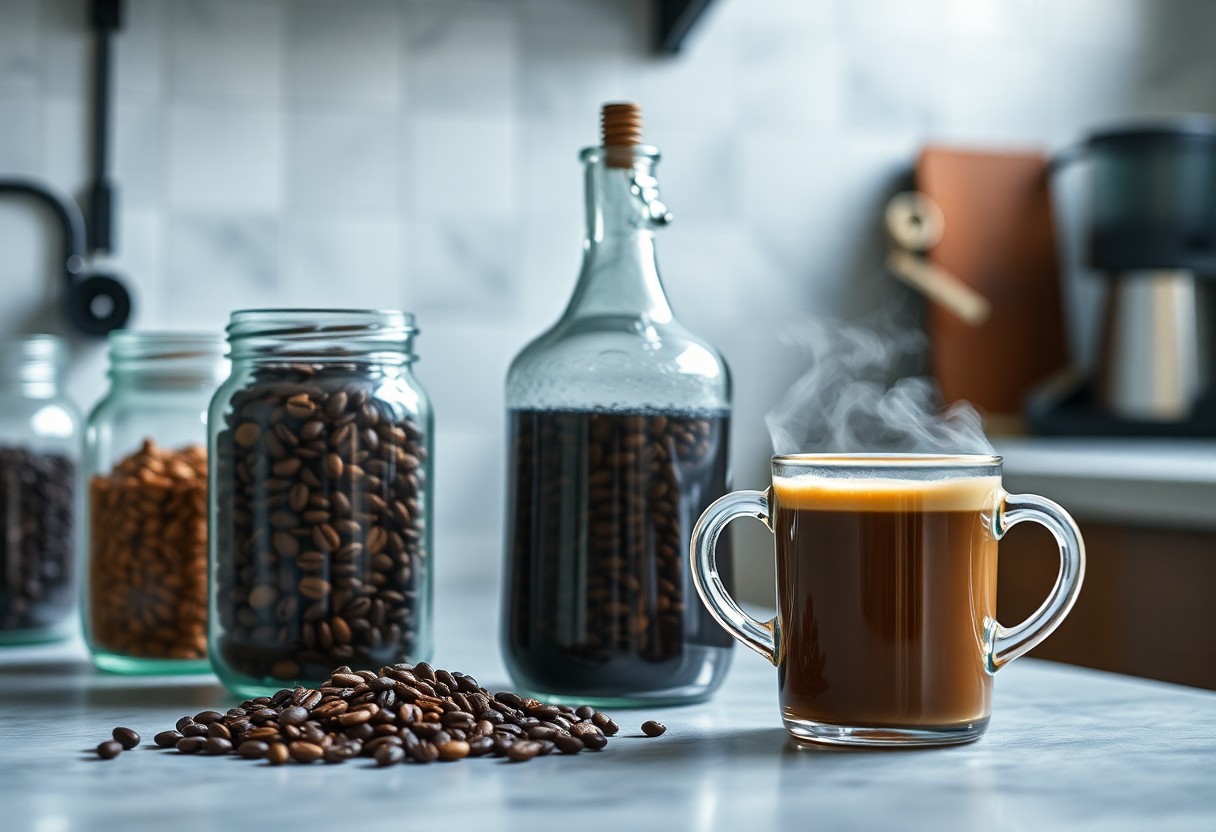Over the years, you may have wondered if it’s possible to remove caffeine from coffee beans at home, especially if you’re sensitive to this stimulant or prefer a decaffeinated option. While there are methods that claim to achieve this, it’s important to understand that these processes can be complicated and potentially hazardous without the right equipment. In this blog post, we’ll explore whether DIY decaffeination is viable, the risks involved, and what alternatives you might consider for enjoying your coffee without the buzz.
Key Takeaways:
- Decaffeination at home is challenging and typically requires specialized equipment and processes that aren’t easily replicable in a kitchen setting.
- Popular methods for reducing caffeine content include using water or solvents, but these methods may not completely remove caffeine and can alter the flavor profile of the coffee.
- For those seeking decaffeinated options, purchasing commercially decaffeinated coffee may offer a more reliable and flavor-consistent solution.
Understanding Caffeine Removal
While caffeine is often celebrated for its stimulating effects, the process of removing it from coffee beans is a blend of science and art. Understanding how caffeine removal works can help you appreciate the complexities involved in making decaffeinated coffee. You may wonder if it’s possible to replicate this process at home, but it is important to recognize the limitations and safety aspects associated with DIY methods.
The Science Behind Caffeine
Removal of caffeine occurs through several mechanisms that target the alkaloid compound without altering the flavor profile of the coffee beans significantly. Typically, this involves water, solvents, or carbon dioxide, which extract caffeine while preserving the beans’ important flavors. Each method affects the beans differently, making the science of decaffeination a fascinating area of study.
Methods for Decaffeination
Against popular belief, decaffeination isn’t as simple as soaking your beans in water. Various methods exist, each with its pros and cons. The most common techniques include the Swiss Water Process, which utilizes water and osmosis to extract caffeine, and solvent-based methods involving substances like methylene chloride or ethyl acetate. While some methods may enhance the bean’s flavor, others could raise health concerns due to chemical residues, making it important to choose wisely.
Plus, understanding these methods better equips you to make informed choices about your coffee consumption. Each process can affect the flavor, aroma, and caffeine retention of the beans. For instance, the Swiss Water Process is chemical-free, offering a more natural option, while solvent methods may be quicker but carry the risk of chemical exposure. Always keep in mind the trade-offs that may affect your health and coffee experience.
DIY Decaffeination Techniques
Some coffee enthusiasts seek to enjoy their beloved brew without the stimulating effects of caffeine. Fortunately, there are a few DIY decaffeination techniques you can try at home. While none are as efficient as commercial methods, experimenting with these methods can be a fun way to satisfy your curiosity and reduce caffeine intake.
Common Home Methods
After considering different techniques, you might choose from the water process, the carbon dioxide method, or just soaking the beans in alcohol. Each has its unique approach to caffeine extraction, allowing you to experiment based on the tools and ingredients you have available.
Pros and Cons of Each Technique
Pros and Cons of Each Technique
| Technique | Pros | Cons |
|---|---|---|
| Water Process | Safe and chemical-free | Can lose flavor |
| Carbon Dioxide Method | Retains flavor better | Requires special equipment |
| Alcohol Soak | Simple household method | Potentially harmful if mismanaged |
| Cold Water Soak | Easy to do | Can take longer |
| Steam Method | Less flavor loss | Results may vary |
Along with each method comes its unique set of benefits and drawbacks. The water process is particularly safe but can sacrifice the flavor profile. The carbon dioxide method retains more flavor, but requires access to specialized equipment, making it less accessible for home use. With the alcohol soak, while it’s a straightforward method, it can be dangerous if not executed properly. Each technique carries potential risks, so approach with caution.
Conclusion
Further exploration into these decaffeination techniques can offer valuable insights for your coffee experience. Understanding the trade-offs between health, safety, and flavor can help you make informed choices as you refine your favorite homebrew. When choosing a method, ensure that you consider the potential risks and rewards, as not all techniques yield the same results. Enjoy the process and experiment wisely!
Choosing the Right Coffee Beans
Unlike conventional coffee brewing methods, selecting the proper coffee beans is vital for your decaffeination process. You’ll want to focus on high-quality beans that can withstand the extraction process while retaining flavor. Look for beans that fit your desired taste profile, as the decaffeination method may affect their ultimate flavor.
Types of Beans Suitable for Decaf
- Arabica – Known for its smooth flavor and lower caffeine content.
- Robusta – Often used for its stronger flavor and higher caffeine, but can be decaffeinated.
- Low-Caffeine Varietals – Naturally contain less caffeine.
- Organic Beans – Minimally processed and may reflect better flavor.
- Single-Origin Beans – Unique flavors based on their growing region.
This selection can significantly impact your final cup.
| Bean Type | Description |
| Arabica | Smooth flavor, lower caffeine |
| Robusta | Stronger flavor, higher caffeine |
| Low-Caffeine Varietals | Naturally less caffeine |
| Organic Beans | Minimally processed |
| Single-Origin Beans | Unique regional flavors |
Freshness and Quality Considerations
Before you start the decaffeination process, it’s necessary to prioritize freshness and quality. Beans lose their flavor over time, degrading the quality of your decaf coffee.
Another key aspect to consider is the roasting date; fresher beans generally produce better flavor and aroma. Be on the lookout for evident signs of staleness such as dullness or absence of aroma. Choose beans that have been sealed properly to maintain their natural oils and flavors. By ensuring premium quality and optimal freshness, you increase your chances of enjoying delicious decaffeinated coffee. This attention to detail can greatly enhance your overall coffee experience.

Potential Pitfalls of DIY Decaf
Many enthusiasts may be attracted to the idea of creating a decaffeinated coffee at home, but there are significant pitfalls to consider. DIY decaf methods often lack the expertise and industrial processes required to effectively remove caffeine without compromising the quality of the beans. Consequently, the variability and safety of these methods may lead to inadequate results, potentially leaving you with beans that are either insufficiently decaffeinated or unpalatable.
Risks and Limitations
Pitfalls arise when you attempt to remove caffeine at home, as many DIY methods can be hazardous. Using improper chemicals or techniques can lead to unhealthy residues in your coffee beans. Moreover, the efficiency of home methods may be inconsistent, resulting in uneven caffeine levels that could still affect sensitive individuals. You may also find that achieving a satisfactory level of decaffeination is challenging, often leading to frustration.
Taste and Aroma Impact
Pitfalls can also extend to the flavor profile of your coffee. Many DIY decaf methods can alter the taste and aroma of the beans, detracting from the rich flavors you love. It’s crucial to note that commercial decaffeination processes are specifically designed to retain the original flavor of the beans, while home methods may not offer the same results.
Consequently, you might find that your homemade decaf lacks both the depth and characteristic notes of regular coffee. While the goal is to enjoy a lower caffeine beverage, many DIY techniques can lead to a brew that tastes flat or overly processed. This could discourage you from indulging in what could have been a delightful cup. Therefore, it’s advisable to weigh your options carefully if you’re aiming for both decaffeination and flavor satisfaction.

Legal and Safety Considerations
After considering a DIY decaffeination project, it’s crucial to understand the legal and safety implications. While experimenting with coffee at home can be fun, ensuring compliance with local regulations regarding food processing is vital. You want to avoid any issues that could arise from improperly applied methods or materials that aren’t safe for consumption.
Regulations on Home Decaffeination
Above all, familiarize yourself with your local food safety laws. Most regions allow home food processing but may have specific regulations concerning the use of certain equipment or chemicals. Always check your local guidelines to ensure your DIY methods comply.
Safety Tips for DIY Enthusiasts
Along your journey to decaf innovation, prioritizing safety is crucial. Use appropriate gear and equipment to prevent accidents or contamination. Follow these tips to enhance your safety while you work:
- Wear gloves to protect your hands from chemicals.
- Use a well-ventilated space, especially if using solvents.
- Keep children and pets away from processing areas.
- Familiarize yourself with the ingredients used in your decaffeination process.
Any mistake could lead to harmful outcomes, so always proceed cautiously and responsibly.
This focus on safety means understanding potential risks as you craft your homemade decaf solution. Keep aware of your environment and any materials you utilize. Here are more suggestions to ensure a safe experience:
- Always use food-grade ingredients to avoid toxicity.
- Have a first aid kit ready for any minor injuries.
- Stay organized to minimize clutter and reduce the risk of accidents.
- Review safety protocols for any equipment you may be using.
Any oversight can lead to unfortunate errors, so be diligent in your approach.
To wrap up
The process of removing caffeine from coffee beans at home is certainly intriguing, but it’s important to recognize that achieving true decaf quality is challenging. While methods like soaking beans or using various solvents can reduce caffeine levels, they often compromise flavor and may not yield the desired results. If you’re looking for a reliable decaf option, it might be best to explore professionally decaffeinated products. Ultimately, understanding the limitations of DIY decaf can help you make informed choices about your coffee experience.
FAQ
Q: What is decaffeination and how does it work?
A: Decaffeination is the process of removing caffeine from coffee beans. There are several methods, including solvent-based processes, water processing, and CO2 methods. Each method involves soaking the beans in water or a solvent that selectively extracts caffeine while attempting to preserve the flavor compounds. While commercial decaffeination is highly efficient, doing it at home is challenging and typically ineffective.
Q: Can I remove caffeine from coffee beans at home?
A: Technically, you can attempt to remove caffeine at home using methods like soaking the beans in water, but these methods are not very effective. Most home methods will not result in significant caffeine reduction and might also alter the flavor of the coffee negatively. Commercial decaffeination techniques are more reliable and preserve the coffee’s taste better.
Q: What materials would I need for a DIY decaf process?
A: If you want to experiment with DIY decaffeination, you would need raw coffee beans, water, a container for soaking, and possibly a filter for separating the beans from the water. Some enthusiasts also use methods involving heat, though this can risk roasting the beans too much, altering their flavors.
Q: Are there any health risks associated with home decaffeination?
A: While there are generally no significant health risks from attempting to decaffeinate coffee beans at home, the main concern is flavor loss. Home methods may lead to an unpleasant taste or texture in the beans. Additionally, improper handling or contamination during the process could pose a health risk, though it’s minimal if basic food safety practices are followed.
Q: Is there a more efficient alternative to drinking decaf coffee?
A: For those looking to reduce caffeine intake without the hassle of DIY decaffeination, consider switching to naturally decaffeinated coffee or caffeine-free alternatives such as herbal teas. These options can provide a satisfying beverage experience without the caffeine-related side effects. Always check the labels to ensure the product meets your desired caffeine level.
